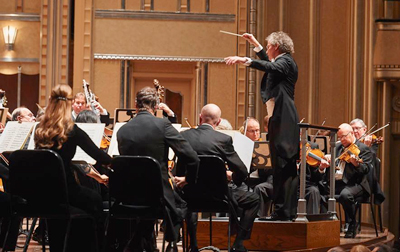by Jeremy Reynolds

Franz Welser-Möst wasted no time upon reaching the podium at the start of the evening’s performance. He conducted the opening of the “Pastoral” in a startlingly lively tempo, as though seeking to energize the symphony through speed alone. While the musicians displayed a comfort with the music born of years of prior performances, the quick tempo — perhaps coupled with the fatigue of this week’s concert-laden schedule — caused the orchestra’s ensemble to occasionally pull apart.
The same can be said of the second movement, in which the violins repeatedly rushed ahead of the lower strings. Despite the somewhat unsteady pulse, the orchestra created a lush palette of sound, though Beethoven’s renowned brook flowed more like a stream due to the movement’s rapid pace. Principal flute Joshua Smith performed the cadenza-like bird calls with the utmost delicacy, his sound blooming softly before melting into the timbre of the oboe and clarinet.
The orchestra rallied to play the latter movements of Beethoven’s homage to nature with a stable, if slightly more conservative, tempo. Frank Rosenwein’s sunny oboe solos in the Scherzo were matched by the spectacularly nimble thunder of the celli and basses in the tempestuous fourth movement. And the orchestra delivered the simple grace of the shepherd’s tune in the finale with serenity, allowing the music (and the musicians) to relax and breathe.
After the austerity of Beethoven’s impressionistic visit to the German countryside, Strauss’s tone poem sounded overcomplicated, forced. The Symphonia Domestica is scored for a large orchestra and depicts everyday occurrences from the composer’s life. Strauss created for himself, his wife, and his child, a collection of short musical motifs that he blended and varied throughout the work to create an aural account of their domestic activities.
His and his wife’s themes are derived from the same intervals but contrast in every other way to demonstrate their marital relationship. Strauss’s theme is in the low strings, pleasant, and full; his wife’s, inverted, in the high woodwinds, quick and shrill. The child’s music alternates between instances of sublime tranquility and scenes of ferocious tantrum.
Robert Walters beautifully introduced the child’s theme on the oboe d’amore, a nearly-extinct instrument of the baroque and early-classical era specifically revived by Strauss to invoke its special, plaintive timbre. Concertmaster William Preucil used just the right amount of expressive schmaltz in his shimmering violin solos, and the noble horn duet at the opening of the third section marvelously contrasted with the often-raucous cacophony of the preceding music.
The orchestra played with clarity as the music picked up momentum in the finale’s double fugue. Even in the heated argument between Strauss and his wife, each of the instrumental voices sounded distinct, yet they melded with the ensemble as a whole. As Welser-Möst led the musicians through the tender reconciliation and into the finale, the orchestra achieved a strength of sound not paralleled at any other point that evening. Strauss’s music is often immoderate, and the orchestra delivered exactly the garish sound that his score called for to leave both the hall and the listeners’ ears ringing with the force of their playing.
Published on ClevelandClassical.com June 2, 2015.
Click here for a printable copy of this article



